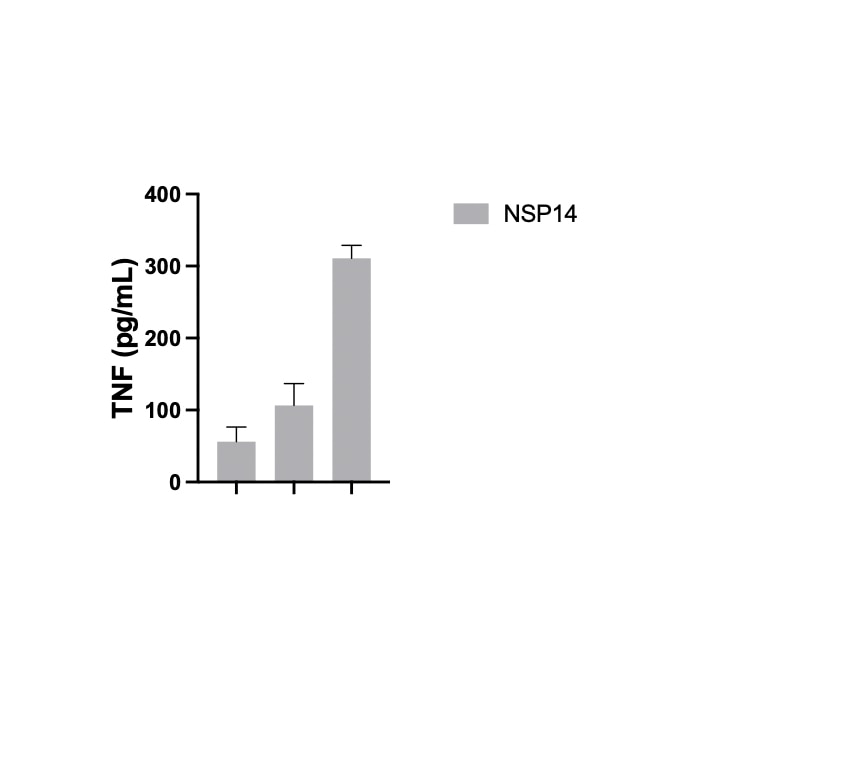Recombinant SARS-CoV-2 NSP14 His-tag Protein, CF Summary
- R&D Systems E. coli-derived Recombinant SARS-CoV-2 NSP14 His-tag Protein (10667-CV)
- Quality control testing to verify active proteins with lot specific assays by in-house scientists
- All R&D Systems proteins are covered with a 100% guarantee
Product Specifications
Ala1-Gln527
with a C-terminal 6-His tag
Analysis
Product Datasheets
Carrier Free
CF stands for Carrier Free (CF). We typically add Bovine Serum Albumin (BSA) as a carrier protein to our recombinant proteins. Adding a carrier protein enhances protein stability, increases shelf-life, and allows the recombinant protein to be stored at a more dilute concentration. The carrier free version does not contain BSA.
In general, we advise purchasing the recombinant protein with BSA for use in cell or tissue culture, or as an ELISA standard. In contrast, the carrier free protein is recommended for applications, in which the presence of BSA could interfere.
10667-CV
| Formulation | Supplied as a 0.2 μm filtered solution in Tris, NaCl, TCEP and Glycerol. |
| Shipping | The product is shipped with polar packs. Upon receipt, store it immediately at the temperature recommended below. |
| Stability & Storage: | Use a manual defrost freezer and avoid repeated freeze-thaw cycles.
|
Reconstitution Calculator
Background: NSP14
Non-structural protein 14 (NSP14) is one of several functional proteins released by ORF1a-encoded protease cleavage of the pp1a and pp1ab replicase polyproteins expressed from the coronavirus (CoV) genome (1). The NSPs are involved in the replication and transcription of the viral RNA and not incorporated within the virion particles. Coronaviruses include various highly pathogenic strains such as SARS-CoV, MERS-CoV and SARS-CoV2 that have had significant impact on humans in addition to strains that have negatively impacted livestock. NSP14 is a bifunctional 527 amino acid enzyme. It contains a noncanonical methyltransferase (MTase) domain in the C‑terminal portion of the protein that methylates guanosine at the N7 position using S-adenosyl methionine (SAM) as a methyl donor to generate the intermediate cap-O structure of the 5' mRNA cap (2). The viral RNA cap structure protects the viral RNA from degradation, promotes mRNA translation, and prevents recognition by innate immune mechanisms (3). As the MTase active site fold is unique from cellular MTases (4), NSP14 presents an attractive antiviral target. The C‑terminal domain is connected via a hinge region to an N‑terminal exonuclease domain composed of three highly conserved motifs (5). The 3' to 5' exonuclease function of the N-terminal domain is responsible for the proofreading and high-fidelity replication observed in coronaviruses compared to other RNA viruses (6-8). NSP14 has been shown to form a complex with NSP10; the association with NSP10 was shown to stimulate exonuclease catalytic activity more than 35-fold and is required for the high replication fidelity (9,10). Exonuclease function makes polymerase inhibition via nucleos(t)ide analog (NA) development more challenging because it confers resistance via its error-correcting mechanism for NA incorporated into RNA (6,9). NSP14 exonuclease domain mutation studies showed it is absolutely required for viability and replication of SARSCoV2 (11) suggesting exonuclease activity may serve a more extensive role in replication than proof-reading (11,12). NSP14 was suggested to be involved in mediating recombination frequency and junction site selection in coronavirus (13). Both for the role it plays in resistance to polymerase inhibition and based on absolute requirement for viability, NSP14 is an appealing protein to target for therapeutic and vaccine development (8,11,13,14).
- Snijder, E.J. et al. (2016) Adv. Virus Res. 96:59.
- Jin, X. et al. (2013) Virus Res. 176:45.
- Decroly, E. et al. (2011) PLoS Pathog. 7:e1002059.
- Chen, Y. et al. (2009) Proc. Natl. Acad. Sci. USA 106:3484.
- Ogando, N.S. et al. (2019) Front. Microbiol. 10:1813.
- Minskaia, E. et al. (2006) Proc. Natl. Acad. Sci. USA 103:5108.
- Eckerle, L. et al. (2007) J. Virol. 81:12135.
- Smith, E.C. et al. (2013) PLoS Pathog. 9:e1003565.
- Bouvet, M. et al. (2012) Proc. Natl. Acad. Sci. 109:9372.
- Smith, E.C. et al. (2015) J. Virol. 89:6418.
- Ogando, N.S. et al. (2020) J. Virol. 94:e01246.
- Baddock, H.T. et al. (2020) (pre-print)
- Gribble, J. et al. (2020) bioRxiv (pre-print)
- Shannon, A. et al. (2020) Antiviral Res. 178:104793.
Citation for Recombinant SARS-CoV-2 NSP14 His-tag Protein, CF
R&D Systems personnel manually curate a database that contains references using R&D Systems products. The data collected includes not only links to publications in PubMed, but also provides information about sample types, species, and experimental conditions.
1 Citation: Showing 1 - 1
-
Investigation of SARS-CoV-2 individual proteins reveals the in vitro and in vivo immunogenicity of membrane protein
Authors: Haystead, T;Lee, E;Cho, K;Gullickson, G;Hughes, P;Krafsur, G;Freeze, R;Scarneo, S;
Scientific reports
Species: Human
Sample Types: Whole Cells
Applications: Bioassay
FAQs
No product specific FAQs exist for this product, however you may
View all Proteins and Enzyme FAQsReviews for Recombinant SARS-CoV-2 NSP14 His-tag Protein, CF
Average Rating: 4 (Based on 1 Review)
Have you used Recombinant SARS-CoV-2 NSP14 His-tag Protein, CF?
Submit a review and receive an Amazon gift card.
$25/€18/£15/$25CAN/¥75 Yuan/¥2500 Yen for a review with an image
$10/€7/£6/$10 CAD/¥70 Yuan/¥1110 Yen for a review without an image
Filter by:


